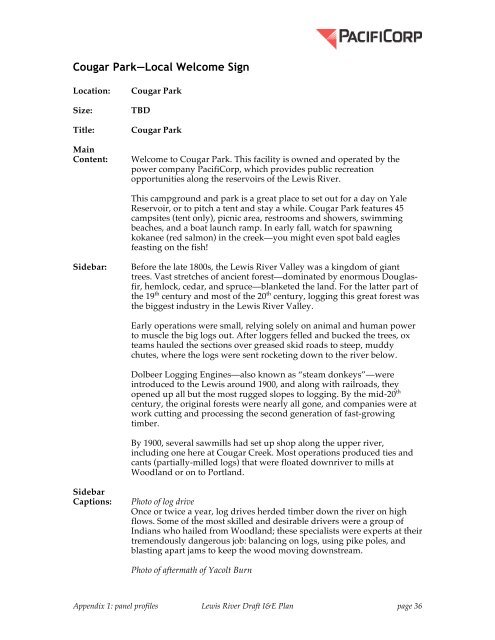The Lewis River Hydroelectric Projects - PacifiCorp
The Lewis River Hydroelectric Projects - PacifiCorp
The Lewis River Hydroelectric Projects - PacifiCorp
Create successful ePaper yourself
Turn your PDF publications into a flip-book with our unique Google optimized e-Paper software.
Cougar Park—Local Welcome Sign<br />
Location:<br />
Size:<br />
Title:<br />
Main<br />
Content:<br />
Cougar Park<br />
TBD<br />
Cougar Park<br />
Welcome to Cougar Park. This facility is owned and operated by the<br />
power company <strong>PacifiCorp</strong>, which provides public recreation<br />
opportunities along the reservoirs of the <strong>Lewis</strong> <strong>River</strong>.<br />
This campground and park is a great place to set out for a day on Yale<br />
Reservoir, or to pitch a tent and stay a while. Cougar Park features 45<br />
campsites (tent only), picnic area, restrooms and showers, swimming<br />
beaches, and a boat launch ramp. In early fall, watch for spawning<br />
kokanee (red salmon) in the creek—you might even spot bald eagles<br />
feasting on the fish!<br />
Sidebar:<br />
Before the late 1800s, the <strong>Lewis</strong> <strong>River</strong> Valley was a kingdom of giant<br />
trees. Vast stretches of ancient forest—dominated by enormous Douglasfir,<br />
hemlock, cedar, and spruce—blanketed the land. For the latter part of<br />
the 19 th century and most of the 20 th century, logging this great forest was<br />
the biggest industry in the <strong>Lewis</strong> <strong>River</strong> Valley.<br />
Early operations were small, relying solely on animal and human power<br />
to muscle the big logs out. After loggers felled and bucked the trees, ox<br />
teams hauled the sections over greased skid roads to steep, muddy<br />
chutes, where the logs were sent rocketing down to the river below.<br />
Dolbeer Logging Engines—also known as “steam donkeys”—were<br />
introduced to the <strong>Lewis</strong> around 1900, and along with railroads, they<br />
opened up all but the most rugged slopes to logging. By the mid-20 th<br />
century, the original forests were nearly all gone, and companies were at<br />
work cutting and processing the second generation of fast-growing<br />
timber.<br />
By 1900, several sawmills had set up shop along the upper river,<br />
including one here at Cougar Creek. Most operations produced ties and<br />
cants (partially-milled logs) that were floated downriver to mills at<br />
Woodland or on to Portland.<br />
Sidebar<br />
Captions:<br />
Photo of log drive<br />
Once or twice a year, log drives herded timber down the river on high<br />
flows. Some of the most skilled and desirable drivers were a group of<br />
Indians who hailed from Woodland; these specialists were experts at their<br />
tremendously dangerous job: balancing on logs, using pike poles, and<br />
blasting apart jams to keep the wood moving downstream.<br />
Photo of aftermath of Yacolt Burn<br />
Appendix 1: panel profiles <strong>Lewis</strong> <strong>River</strong> Draft I&E Plan page 36
















